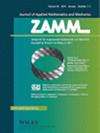纤毛与粘性流体相互作用的连续活动结构模型
IF 3.2
4区 工程技术
Q1 MATHEMATICS, APPLIED
Zamm-zeitschrift Fur Angewandte Mathematik Und Mechanik
Pub Date : 2023-10-05
DOI:10.1002/zamm.202100534
引用次数: 1
摘要
摘要本文提出了一个薄主动结构与粘性流体相互作用的模型,以及由此产生的流固相互作用问题的离散化和数值模拟。所开发的模型可以重现纤毛或鞭毛浸入粘性流体中的行为。在线性或非线性弹性的背景下,该模型基于一个合适的内部Piola‐Kirchoff张量的定义,该张量模仿了引起结构运动的内部动力的作用。在随后的流体-结构相互作用问题中,出现并讨论了两个困难:一方面,结构的内部活动导致更严格的井定性条件,另一方面,流体和结构之间的耦合条件需要特定的数值处理。在包含耦合条件的泛函空间中,导出了时间离散问题的弱公式,但出于数值目的,为了摆脱泛函空间中的约束,引入了使用拉格朗日乘子的等效公式。这种新的公式允许使用标准(流体和结构)求解器,直至迭代过程。数值模拟,包括一个或两个纤毛在二维的跳动,讨论了内部活动的大小和周围流体的粘度之间的竞争。本文章由计算机程序翻译,如有差异,请以英文原文为准。
A continuum active structure model for the interaction of cilia with a viscous fluid
Abstract This paper presents a model for a thin active structure interacting with a viscous fluid, as well as a discretization and numerical simulations of the arising fluid‐structure interaction problem. The developed model allows to reproduce the behavior of cilia or flagella immersed in a viscous flow. In the context of linear or nonlinear elasticity, the model is based upon the definition of a suitable internal Piola‐Kirchoff tensor mimicking the action of the internal dyneins that induce the motility of the structure. In the subsequent fluid‐structure interaction problem, two difficulties arise and are discussed: on the one hand the internal activity of the structure leads to more restrictive well‐posedness conditions and, on the other hand, the coupling conditions between the fluid and the structure require a specific numerical treatment. A weak formulation of the time‐discretized problem is derived in functional spaces that include the coupling conditions, but for numerical purposes, an equivalent formulation using Lagrange multipliers is introduced in order to get rid of the constraints in the functional spaces. This new formulation allows for the use of standard (fluid and structure) solvers, up to an iterative procedure. Numerical simulations are presented, including the beating of one or two cilia in 2d, discussing the competition between the magnitude of the internal activity and the viscosity of the surrounding fluid.
求助全文
通过发布文献求助,成功后即可免费获取论文全文。
去求助
来源期刊
CiteScore
3.30
自引率
8.70%
发文量
199
审稿时长
3.0 months
期刊介绍:
ZAMM is one of the oldest journals in the field of applied mathematics and mechanics and is read by scientists all over the world. The aim and scope of ZAMM is the publication of new results and review articles and information on applied mathematics (mainly numerical mathematics and various applications of analysis, in particular numerical aspects of differential and integral equations), on the entire field of theoretical and applied mechanics (solid mechanics, fluid mechanics, thermodynamics). ZAMM is also open to essential contributions on mathematics in industrial applications.

 求助内容:
求助内容: 应助结果提醒方式:
应助结果提醒方式:


